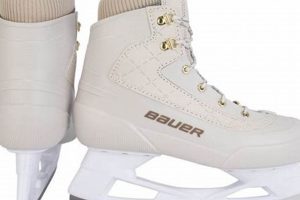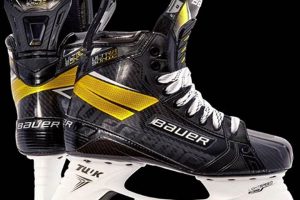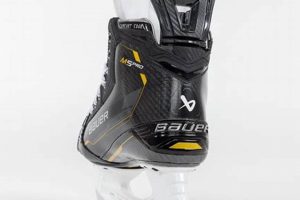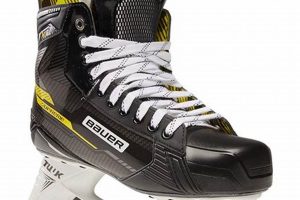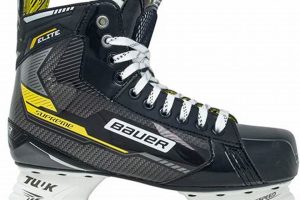A specialized equipment carrier designed for ice hockey or figure skating, this product facilitates the transportation of skates and related gear. Typically constructed from durable materials like reinforced nylon or polyester, it often features compartments to separately store skates, apparel, and accessories, preventing damage and promoting organization.
The utility of these carriers stems from their protective function and organizational capacity. Historically, skaters relied on less sophisticated methods for transporting equipment, leading to potential damage and inconvenience. Modern versions offer enhanced durability, ventilation to minimize odor, and ergonomic designs for comfortable carrying, significantly improving the user experience and protecting valuable equipment.
The subsequent sections will delve into the specific features, common types, and considerations for selecting the appropriate equipment carrier to meet individual needs and ensure the longevity of skating equipment.
Essential Considerations for Equipment Carriers
The following points offer guidance for maximizing the lifespan and utility of specialized equipment carriers for ice skates, ensuring proper protection and organization.
Tip 1: Material Durability: Prioritize models constructed from high-denier nylon or reinforced polyester. These materials resist abrasion and tearing, crucial for withstanding frequent use and transport.
Tip 2: Ventilation is Paramount: Select carriers with integrated ventilation systems, such as mesh panels or strategically placed grommets. Adequate airflow minimizes moisture buildup, preventing the growth of bacteria and reducing unpleasant odors.
Tip 3: Skate Compartment Integrity: Ensure the skate compartments are padded and reinforced to prevent blade damage to other gear. Individual sleeves or dividers offer additional protection against scratches and abrasions.
Tip 4: Zipper Quality: Investigate the zipper construction. Heavy-duty zippers with reinforced stitching are less prone to failure, maintaining the integrity of the carrier’s closure system.
Tip 5: Handle and Strap Ergonomics: Assess the comfort and durability of handles and shoulder straps. Padded grips and adjustable straps distribute weight evenly, reducing strain during transport. Reinforcement at stress points is essential.
Tip 6: Size and Compartmentalization: Choose a size that accommodates all necessary equipment without excessive bulk. Multiple compartments facilitate organized storage, separating skates from apparel and accessories, thus minimizing potential damage.
Tip 7: Regular Maintenance: Periodically clean the carrier’s interior with a mild detergent and water. Promptly address any rips or tears to prevent further damage and maintain functionality.
Adherence to these suggestions will contribute significantly to the longevity of the equipment carrier, safeguarding valuable skating gear and simplifying transport logistics.
The subsequent section will explore advanced features and considerations for specialized user needs.
1. Durable Material Construction
The longevity and protective capacity of an equipment carrier are directly proportional to the quality of its material construction. For specialized skate equipment carriers, such as those marketed under the “nike bauer” brand, durable materials are not merely a cosmetic feature, but a critical component ensuring the safe transport and storage of valuable ice skates and related gear. The inherent impact resistance of high-denier nylon or reinforced polyester, for example, minimizes the risk of damage from external forces encountered during transit, a common occurrence when moving equipment to and from ice rinks.
Consider a scenario where a skater transports their equipment carrier in the cargo area of a vehicle alongside other heavy objects. A carrier constructed from substandard materials is susceptible to tearing or puncture, potentially exposing the skates to damage. Conversely, a carrier featuring reinforced seams and robust fabric, characteristic of durable construction, provides a protective barrier, mitigating the risk of damage from shifting cargo. This principle extends to the abrasive forces encountered during repeated use, such as dragging the carrier across rough surfaces or storing it in locker rooms with limited space.
In summary, durable material construction is paramount to the performance and lifespan of a “nike bauer” skate equipment carrier. It directly influences the level of protection afforded to the skates and gear, ultimately impacting the skater’s ability to rely on their equipment remaining in optimal condition. The selection of a carrier constructed from high-quality materials represents a long-term investment in the preservation of skating equipment and the mitigation of potential damage incurred during transport and storage.
2. Ventilation System Efficacy
Ventilation system efficacy within the context of a “nike bauer skate bag” directly impacts the hygienic conditions and longevity of the stored equipment. Inadequate ventilation fosters an environment conducive to bacterial growth and odor accumulation, primarily due to trapped moisture from perspiration-soaked gear. This, in turn, can degrade the materials of both the carrier itself and the valuable skates contained within. A well-designed ventilation system, typically employing mesh panels or strategically placed vents, actively promotes airflow, facilitating the evaporation of moisture and inhibiting microbial proliferation. For example, skates stored in a poorly ventilated carrier after a rigorous practice are prone to developing unpleasant odors and may even experience premature degradation of the boot leather and internal padding.
The practical application of effective ventilation systems extends beyond mere odor control. By minimizing moisture buildup, these systems contribute to the prevention of rust and corrosion on skate blades, a critical factor in maintaining optimal performance. Furthermore, the reduction in humidity levels within the carrier can mitigate the growth of mold and mildew, safeguarding both the equipment and the health of the user. Consider a scenario where a skater consistently stores damp skates in a poorly ventilated environment; the prolonged exposure to moisture will inevitably lead to accelerated deterioration of the skate blades and internal components, requiring more frequent maintenance or replacement. Conversely, a carrier with an efficient ventilation system will help to preserve the integrity of the skates over an extended period.
In summary, the efficacy of a ventilation system in a “nike bauer skate bag” is not merely a cosmetic feature, but a crucial component directly impacting the hygiene, performance, and longevity of the stored equipment. Addressing this element through careful design and material selection presents a tangible benefit to users, promoting both the preservation of their investment and a more pleasant experience. The challenge lies in balancing ventilation requirements with structural integrity and water resistance, necessitating a holistic approach to carrier design.
3. Compartmentalized Organization
Compartmentalized organization, as a design principle integrated into a “nike bauer skate bag,” serves a critical function in protecting and managing valuable skating equipment. The distinct separation of items prevents damage, maintains hygiene, and facilitates efficient access. Without dedicated compartments, skate blades could easily scratch or tear delicate fabrics, while wet apparel could contaminate dry goods. Therefore, compartmentalization directly mitigates potential harm and promotes the longevity of both the bag and its contents. A typical example involves a dedicated skate compartment lined with protective material, separate from a ventilated apparel section, ensuring blades do not damage clothing and that moisture does not spread. This structured approach enhances the usability and protects the investment in skating gear.
The practical implications of compartmentalized organization extend beyond basic protection. A skater can rapidly locate specific items within a well-organized bag, saving time and reducing pre-game or practice stress. Smaller compartments for accessories, such as skate tools, tape, or spare laces, prevent these items from being lost or damaged among larger pieces of equipment. Moreover, a designated wet storage area, typically constructed with water-resistant materials, isolates damp clothing and prevents odor transfer. This structured system enables efficient packing and unpacking, maximizing usability and streamlining the skating experience. Failure to adopt such organization leads to disorganized equipment, increasing the risk of damage and delaying preparation.
In conclusion, compartmentalized organization is an essential element of the “nike bauer skate bag,” providing practical benefits that extend from protection to efficiency. It represents a deliberate design choice that contributes significantly to the bag’s overall value proposition. The absence of effective compartmentalization diminishes the bag’s functionality and increases the likelihood of equipment damage and disorganization. Therefore, evaluating the quality and design of a bag’s compartments is crucial when selecting a carrier that meets the demands of serious skaters and maintains their equipment in optimal condition.
4. Ergonomic Design Features
Ergonomic design features are integral to the functionality and user experience of a “nike bauer skate bag,” directly influencing comfort, convenience, and injury prevention during transport of heavy and often unwieldy skating equipment. The inherent weight and bulk associated with skates, protective gear, and apparel necessitate a design that minimizes strain on the user’s musculoskeletal system. Poorly designed bags lacking ergonomic considerations can lead to back pain, shoulder discomfort, and increased risk of injury. Therefore, the presence and quality of ergonomic elements are critical determinants of a bag’s practical utility and overall value. For example, a bag with poorly placed or unpadded shoulder straps will concentrate pressure on a small area, leading to discomfort and potential muscle strain, especially when carrying the bag for extended periods or over long distances.
The practical implementation of ergonomic design in a “nike bauer skate bag” manifests in several key features. Padded shoulder straps, adjustable to accommodate varying body types and carrying preferences, distribute weight more evenly across the shoulders, reducing pressure points and improving comfort. Contoured back panels, often incorporating breathable mesh, promote airflow and minimize contact between the bag and the user’s back, reducing perspiration and preventing overheating. Strategically placed handles, designed for comfortable grip and balanced weight distribution, facilitate easy lifting and maneuvering. Furthermore, the overall bag geometry, including its dimensions and center of gravity, contributes to ergonomic performance by minimizing the need for awkward or strained postures during transport. A bag designed with a low center of gravity, for instance, will be more stable and easier to control, reducing the risk of imbalance and potential injury. These principles not only make it easier to carry the bag but may improve performance as the skater will less likely be tired before even step on ice.
In conclusion, ergonomic design features are not merely aesthetic enhancements but essential components of a “nike bauer skate bag,” directly impacting user comfort, safety, and overall satisfaction. The incorporation of padded straps, contoured panels, and strategically placed handles contributes to a more efficient and comfortable carrying experience, minimizing the risk of injury and maximizing the bag’s practical utility. Selecting a bag that prioritizes ergonomic design is a prudent investment that can significantly improve the skater’s experience and protect their physical well-being. The ongoing challenge lies in balancing ergonomic considerations with durability, storage capacity, and aesthetic appeal, requiring a holistic approach to bag design and manufacturing.
5. Blade Protection Integration
Blade protection integration within the design of a “nike bauer skate bag” is a crucial element that directly impacts the longevity, performance, and safety of ice skates. This integration extends beyond merely providing a storage compartment; it encompasses a series of design features aimed at mitigating potential damage to the blades during transit and storage. The absence of adequate blade protection can lead to nicks, rust, and dulled edges, negatively affecting a skater’s performance and increasing the frequency of costly sharpening and repairs.
- Reinforced Skate Compartments
The skate compartments within a “nike bauer skate bag” often feature reinforced materials and construction specifically designed to withstand the sharp edges of skate blades. High-denier nylon or ballistic polyester linings resist punctures and tears, preventing the blades from cutting through the bag and potentially damaging other equipment or posing a safety hazard. This reinforcement acts as a barrier, minimizing the risk of contact between the blades and the bag’s exterior or other internal contents.
- Blade Sleeve Accommodation
Many “nike bauer skate bags” incorporate design elements that facilitate the use of blade sleeves or guards. These sleeves, typically made of absorbent terrycloth or durable plastic, cover the blades, providing a protective layer against moisture and physical impact. The bag’s skate compartments are often sized to comfortably accommodate skates with these sleeves in place, ensuring that the sleeves remain secure during transport and storage.
- Internal Dividers and Padding
To further enhance blade protection, some “nike bauer skate bags” feature internal dividers or padding within the skate compartments. These dividers separate the skates, preventing them from rubbing against each other and minimizing the risk of edge damage. Padding, strategically placed within the compartments, absorbs impact and provides additional cushioning, protecting the blades from shocks and vibrations encountered during transit.
- Ventilation and Moisture Control
The integration of ventilation systems within the skate compartments also indirectly contributes to blade protection. By promoting airflow and reducing moisture buildup, these systems minimize the risk of rust and corrosion on the skate blades. This is particularly important after use, when the blades may be damp from ice and snow. Ventilation helps to dry the blades quickly, preventing the formation of rust that can compromise their sharpness and performance.
These integrated blade protection features demonstrate the “nike bauer skate bag’s” commitment to preserving the integrity and performance of valuable skating equipment. By addressing the specific risks associated with blade damage during transport and storage, these bags offer a practical solution for skaters seeking to protect their investment and maintain optimal performance. The effectiveness of blade protection integration is a key factor in differentiating high-quality skate bags from less sophisticated alternatives.
Frequently Asked Questions
The subsequent section addresses common inquiries regarding specialized equipment carriers, aiming to provide clarity on features, maintenance, and optimal usage practices.
Question 1: What materials offer the best durability in a specialized equipment carrier?
High-denier nylon and reinforced polyester provide superior resistance to abrasion and tearing, essential for withstanding frequent use and transport. These materials maintain structural integrity under stress.
Question 2: Why is ventilation important in equipment carriers?
Ventilation minimizes moisture buildup, inhibiting bacterial growth and reducing unpleasant odors. Adequate airflow also prevents rust and corrosion on skate blades.
Question 3: How should skate compartments be designed to protect blades?
Skate compartments require padding and reinforcement to prevent blade damage to other gear. Individual sleeves or dividers offer additional protection against scratches and abrasions.
Question 4: What factors contribute to ergonomic design in a specialized equipment carrier?
Padded grips, adjustable straps, and balanced weight distribution reduce strain during transport. Reinforcement at stress points is essential for handle and strap longevity.
Question 5: How does compartmentalization enhance the functionality of an equipment carrier?
Compartments facilitate organized storage, separating skates from apparel and accessories, minimizing potential damage and streamlining access to specific items.
Question 6: What maintenance practices extend the lifespan of a specialized equipment carrier?
Periodic cleaning with a mild detergent and water is recommended. Promptly addressing any rips or tears prevents further damage and maintains functionality.
In summary, the selection of durable materials, effective ventilation systems, and thoughtful design features are paramount for ensuring the longevity and utility of equipment carriers. Regular maintenance further contributes to their continued performance.
The subsequent section explores advanced considerations and specialized user needs.
Concluding Remarks on Specialized Equipment Carriers
This exploration has illuminated the critical design and functionality aspects of the “nike bauer skate bag.” Key points include material durability, ventilation effectiveness, compartmentalized organization, ergonomic considerations, and blade protection integration. Each element contributes directly to the safe and efficient transport of valuable skating equipment, influencing both performance and longevity.
The informed selection of a “nike bauer skate bag,” based on a thorough understanding of its features and benefits, represents a strategic investment in equipment preservation and user well-being. As skating technology evolves, so too will the demands placed on specialized carriers, necessitating continued innovation and adherence to the highest standards of design and construction. The future utility of these essential tools hinges on their ability to adapt to the evolving needs of skaters and their commitment to safeguarding valuable equipment.


